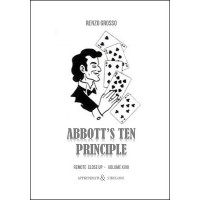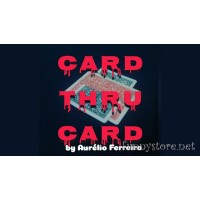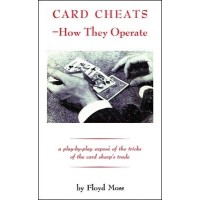Germain The Wizard by Stuart Cramer
- Product Code: C#22628
- Reward Points: 195
- Availability: In Stock
- $322.00
-
$39.99
- Price in reward points: 3999
The word "unique" is widely misused and routinely abused; today we even hear television "journalists" announcing how this person is "very unique" and this product is "quite unique," when in fact the word cannot be modified in its correct usage, for something is either unique or it is not, and there is no in between.
Without doubt, Karl Germain was unique, in magic and in life. No one who has read the two marvelous Smart Cramer books about Germain can doubt this. In the 1970s, when I came upon Cramer's 1962 text, The Secrets of Karl Germain, I was intrigued, but I didn't fully "get it" immediately. It was not until some years later when I located a copy of the 1966 book, Germain the Wizard and his Legerdemain that I was seized with a deep appreciation for Germain's work. Ever since then I have often said that, had I the chance to go back and see any magician of the 20th century, Germain would be among the two or three at the top of my wish list.
The reasons for that fascination have much less to do with the specific tricks that Germain performed than with what can only be described as his artistic sensibility. As one reads through the Germain material, one cannot escape the fact that this was a man with a distinct aesthetic point of view that was reflected in every aspect of his work, from his props and costume and stage sets to his presentations and indeed his approach to method. And the fact that one sees this in so many elements of his work speaks to what may be his most striking trait of all, and that is his exhaustive attention to detail; "alarming exactitude" is the phrase that Stuart Cramer uses in describing Germain's approach to the "Rising Cards." Germain was not merely an absolute professional, but a perfectionist.
And yet, he was not the kind who uses a gloss of perfectionism to cover a deadly impracticality or an inability to completely solve problems. Rather he was a perfectionist with an unwavering grasp on reality. There is a practicality to Germain's work that is scrupulously modern, which is why his thinking about methods, and especially misdirection, are still extremely relevant to modern conjuring. One will have to study and think in order to glean these lessons, because given the fact that his material was of course of its time, much is not ripe to be readily plucked and served to current audiences. But if one goes beyond the period gloss, there are countless ideas here that are ready to be put to the good and hard work of real-world conjuring.
And many have, for better or worse. Germain was the inventor of the Daylight Séance, although he did not burn the principle as a sight gag but used it to portray one of his favorite subjects, namely the theatrical performance of spirit manifestations. Germain's influence can be seen elsewhere in contemporary conjuring if one knows where to look; he devised the now popular method for the torn-and-restored cigarette paper in which the duplicate is attached to the thumbnail with wax. One of Germain's per effects (with which he managed to fool Harry Houdini) was the appearance of "spirit" writing on a cigarette paper, a favorite routine of Eugene Burger's (complete with Germain's original opening line: "Do you believe in spirits?"). And who has never seen the popular novelty illusion of the suspended, detached faucet which mysteriously provides a steady stream of water a Karl Germain invention!
Born Charles Mattmueller, Jr. in Cleveland in 1878. the future Karl Germain was already working professionally in his teens, and achieved surprisingly early success on the Lyceum and subsequently Chatauqua circuits. While the latter was populated by lecturers and "serious" artists who would bring culture to Middle America, Germain's high style and articulate speech enabled him to in the market admirably. The Cramer books recount the incredibly demanding work and lifestyle of this world, with months upon months of sine-night stands, long travel days, brutal weather, and difficult lodgings. The money was good and the work was steady, but few of today's comfortable corporate performers would be willing to trade their working and travel conditions in return for the enviably full booking calendars of the successful Chatauqua entertainer.
The story of Karl Germain might appear an inspiring or tragic one, depending on your point of view; the fact is, it is both. We owe it to Stuart Cramer that we know much of the story at all. As a boy Cramer discovered that Germain lived in the same city, and Cramer, a budding magician, sought out Germain, who was already long retired due to blindness, caused by brain surgery to remove a tumor. In fact, Germain's successful career had been cut short by his condition, and he was forced to retire before he had reached age 40. But Cramer and Germain established a profoundly important relationship, and Cramer continued to visit Germain almost weekly for the next 25 years, throughout Cramer's life m a professional magician, learning magic, taking notes, listening and talking to Germain until his death. Although Germain was excruciatingly secretive and was extremely resistant to seeing his own material in print during his lifetime and even afterward, as he often told Cramer the latter eventually broke the silence and decided to go public in 1962 with his first book of Germain material. The second book is even more substantive, being as it is a smartly constructive narrative about Germain's life as well as his magic, with the two elements cleverly integrated through anecdotal segues. We must be grateful in the extreme to Stuart Cramer for rescuing Germain's name and material and recording his life and work for our benefit. It would be tragic indeed had we not the chance to appreciate Germain's gifts and contributions, as well as having the opportunity to learn from his creative output. Were it not for Smart Cramer, Germain would never have received the credit that is his due, and while countless secrets would have been lost forever, others might well have been re-invented and thereby mistakenly credited. Should Ottokar Fischer have obliged Hofzinser's wishes and burned his material, forever robbing him of the credit he so richly deserved, and relegating his name to obscurity? I am invariably mystified by those who claim to respect their mentors and thereby utilize secrecy to turn their heroes into footnotes.
If you haven't read the two Smart Cramer books they've become a bit scarce in recent years you are in for a remarkable experience in reading this book, because they comprise the heart of it. Concerning those two works, Cramer's original drawings have been redrawn for clarity and consistency by artist Katlyn Breene, who also created the dust jacket. The books are now heavily illustrated throughout with relevant memorabilia, from flyers of his first show to medical records of his brain surgery. Along with this material there is Cramer's series from Mystic Quarterly entitled "This Old House," which recounts his search (along with a family member) of Germain's home, after the latter's death, for hidden treasures. A brief biography of Cramer, written by Phil Willmarth for a 1985 Linking Ring is also included, a valuable appreciation of Cramer's own considerable accomplishments.
If that was the entire package the book would already be a "must-have," but in many ways it is only the beginning; the complete volume is well over 500 pages! An opening essay by David Ben offers commentary from a man who has probably used more Germain material than any other contemporary magician, including the "Egyptian Water Jars" and Germain's favorite, the "Growth of Flowers." Ben explains that he is "... attracted to Germain's magic because of its intoxicating blend of visual deception, mystery, and imagination."
So even if you are intimate with the Cramer titles, there is a fountain of new material in which to bathe, accumulated and organized by Todd Karr, and amassed from numerous sources, notably the collections of Ken Klosterman and the American Museum of Magic. There is a section devoted to new information about Germain effects and another containing nothing but Germain's original, exquisitely detailed scripts; many of the tricks and scripts were either handwritten or typed carbon copies that Germain had saved, all of which were transcribed and deciphered word for word. Other sections include: correspondence both to and from Germain, including the likes of Harry Kellar, and Germain's protégé, Paul Fleming; a section on the "Spirit Cabinet," a Favorite item of Germain's, including the revelation of a previously unpublished one-man method; a huge section just of brochures; another substantial section of Germain's own scrapbooks of press clip-pings; there is an early hand-written notebook of Germain's conjuring ideas; there is a section containing transcriptions of two lectures, one given very late in his life at an S.A.M. meeting (an audio recording of which is included with the deluxe edition, along with a recording of some of his stage music); a chapter of original verse accompanied by Germain sketches; all of which is generously laden with photos and memorabilia, much of which has been seen by few people if any before now. It is, in short, a glorious piece of work.
Todd Karr seems to be carving out a niche in these historical volumes; while they may require less effort than original biography, enabling him to produce them at a surprising pace, nevertheless the amount of work required to produce books like this or the recent The Silence of Chung Ling Sao seems remarkable to say the least, and I for one am grateful for the results. Each one of his books has been issued in 1,000-copy print runs, and each run has already sold out, including the limited editions. This book will surely be no different and, considering its size and beauty, it might well become the most desirable to collectors so far.
The life story of Germain, the man and the magician, is reason enough to read this book, but there are important lessons to be learned here for any thinking student of the art. Even the Germain epigrams are food for much thought. Consider "Be an artist. Don't go around picking up things on the stage, or lifting or pushing. What is more ludicrous than the great wizard granting and pushing a heavy cabinet?"
And any master magician would endorse this piece of unarguably contemporary advice: "An orderly and punctilious style will always remain in favor with the discriminating; selecting every detail with the 'whole constantly in mind leaving nothing to chance, and adding no embellishments just because they are good in themselves that is the secret of clear-cut entertainment."
Of course, these are not plug-and-play concepts; they require considerable thought and effort in order to put them to good use. But the lessons run deeper still, lessons of diabolical conjuring thinking. Consider one stunning methodological moment from the "Complete Mental Telegraph Act." In this, the moment arrives when Germain is on stage and in possession of a carbon copy of three names written by audience members. The action proceeds: "Returning to the stage he surreptitiously extracted the sheet and, noticing a scrap of newspaper on the floor near the footlights, left there from a previous part of the program ... He neatly picked up the newspaper, balled it around the message carbon sheet and tossed it offstage, going then to the table and depositing there the remainder of the envelopes." Thus the information was transmitted to his backstage assistant, which was then in turn coded back to Germain on stage, via the means of, believe it or not, a thread.
The most difficult lessons of all lie in Germain's artistic spirit. This book is brought to a close with an essay by Teller, a Germain aficionado of longstanding. (On their television series, Penn & Teller's Sin City Spectacular, for which I served as a writer and magic designer, Teller has used a method from Germain's "The Short and Precarious Career of Miss Confetti" to turn a tumbler of rice into live maggots, an effect Germain would likely have appreciated, considering an anecdote herein in which he used a magic principle to apparently consecutively catch a number of flies on the wing, and another bit with an animated bed bug!) In this insightful and thought-provoking contribution, Teller observes that, "Caught up in the difficulty of mystifying, magicians often forget that the first job of any artist is to communicate a beautiful idea. ... Germain's work shows us the power of beautiful ideas."
Surely there is a great deal we can learn from Germain; about beautiful ideas, and still more. Germain was a modernist in many ways; doing a two-hour show on the Chatauqua circuit, he was con-strained from traveling with huge props or stage traps, standard equipment of the era of big shows, and he worked on simple plat-forms which he converted into the appearance of a theatrical stage. His show truly had to "pack small and play big," and his methods had to be as practical as his props. His methods were not complex they were positively simple at times but they were applied with tremendous subtlety and care. The misdirection was ingenious; the properties exquisite; the presentations masterful. This was an artist firing on every creative cylinder.
It has always seemed difficult to me to place Germain in a precise historical instant. His was a time of transitions in magic, and of course he had his feet planted in two centuries, and across stylistic eras. Yet there is a modernity to much of his thinking that we can recognize today partly in his eye toward practicality, but also in his sophisticated approach to art and deeply clever thinking about method and misdirection. It seems to me that if you adjust for the specifics of language and presentation often but far from always based on cultural interests of the day Germain is far more modem than many others we read about of his time, or of just prior, or even of later. Although he used apparatus, it tended to be disguised as normal or else heavily justified; this was not the Die Box and Square Circle. And that is an interesting and in fact rather modern take on general magic with small apparatus. To me he seems a world away from Hoffman and Hermann.
Yet while Germain seems a bridge in many ways, I don't think that explains much about why he stands out as he does. I think it's important to recognize that you can't simply plug his likes into time or place or even evolutionary station; rather, he was in fact unique, a one-of-a-kind artist who would not have fit into any mold no matter when he had lived and worked.
In the lecture which he gives to S.A.M. Assembly 10 in 1949, Germain blind and long retired from magic implores his audience in lofty terms to strive for originality, to add their own "unique and peculiar personality" to their work. Germain says that there are two kinds of people in the world, "those who create values and those who exploit and destroy them." He declares that "No man can better this world without an art," and muses that when our time on earth comes to an end, "We have either enriched and bettered the world, by our little addition, or large, or we have made it a little worse and a poorer place for those who follow us to live in."
Karl Germain bettered his world, and created value with his art. We are fortunate indeed to know about it, all the more so with this new volume of details about his life and work, and perhaps it can assist a few of us in trying to uphold his standards. If you call your-self a magician. if you have dreams of being an artist, then you want you need to experience this book.
Germain The Wizard - Stuart Cramer - 8" x 10" - hardbound with full color dustjacket - illustrated with 100 drawings (redrawn by Breene from Cramer) - 12 full-color pages & more than 350 illustrations of various memorabilia - 2002 - 624 pages
Reviews (0)
Related Products
Perplex by Criss Smith
Seasoned performer Criss Smith brings you his DVD Perplex, full of worker material fine-tuned i..
$1.99 $6.99
Cyclic Ring by Rodrigo Romano
Mysteries presents CYCLIC RING by Rodrigo Romano! "CYCLIC RING is a ground..
$1.99 $5.99
Watch The Watch by Mott-Sun
A one-coin routine with a powerful kicker! Mott-sun finally releases the secret to his FISM act! ..
$1.99 $5.99
Nesura by Nesmor
At last, the secret to Nesmor's signature techniques is out! Get ready for card manipulations t..
$1.99 $4.99
Perspective by Julio Montoro
The ability to impact someone's perspective can truly feel like mind manipulation..And that's exactl..
$1.99 $4.99
Recommend
Secret Tools & Strategies by Richard Mark & Mark Salem
Secret Tools & Strategies by Richard Mark & Mark Salem..
$16.99 $80.00
Easy Touch by Ian Baxter
Paul Curry is a name that captures the attention of magicians everywhere, thanks to his famous card ..
$1.99 $8.00
Remote Close Up 18: Abbott'S Ten Principle by Renzo Grosso
THE ABBOTT'S TEN PRINCIPLE: The principle, generally called Abbott's Ten by the Americans, actually ..
$3.99 $14.00
Card Thru Card by Aurélio Ferreira
A perfect solid through solid illusion!Two cards pass through each other.Looks like real magic. Try ..
$1.99 $10.00
Target (Explanation Only)(Video+Pdf) by Sebastien Macak
Take a photo of five items.Put the phone face down.Then ask someone to choose one of the items.Flip ..
$0.99 $26.00
Fantastique (Français) by Antoine Salembier
Il nous aura fallu près de 5 ans pour finaliser ce projet d'envergure ! Ce coffret, c'est ..
$18.99 $191.00
Portal by Peter Eggink & Armanujjaman Abir
Magic done with ordinary objects is still the best magic one can do.Back in 2018 Armanujjaman Abir s..
$2.99 $77.00
Card Cheats: How They Operate by Floyd Moss
A play-by-play exposé of the tricks of the card sharp's trade.Moss gives general advice on how to av..
$4.99 $17.00
Further Tricks Without Names by Werner Miller
Minor math-based tricks and procedural surprises.Enjoy another free sample of Werner Miller's creati..
$0.00 $2.01
Ultimate Bowling Ball From Briefcase by Richard Griffin
EFFECT:A briefcase is opened and shown to be empty. It's then closed, turned upside down, opened aga..
$1.99 $272.90
Im Fokus Nr. 17: Ferrofluid by Christian Scherer
Eine neuartige, kommerzielle Kartenroutine zum Thema 'ehrgeizige Karte' mit einem unpräparierten Kar..
$2.99 $11.95
Smoke Pad by Wang Ji & Bacon Magic
The Smoke Pad balances size and portability, you can spread a full deck of cards on it. It..
$2.99 $401.95
Overdraft by Paul Fowler
They say crime doesn't pay, but whoever said that didn't own Overdraft.Overdraft is a set ..
$1.99 $51.95
Changeling by Peter Eggink
"Changeling" by Peter EgginkA super visual, hands-off card change.A card is selected (signed) by the..
$1.99 $39.50






















